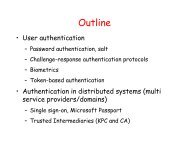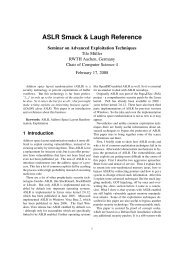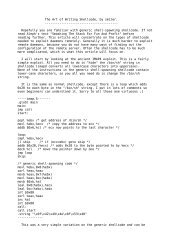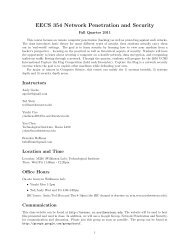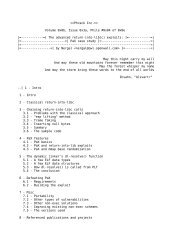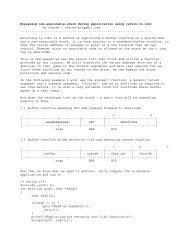Fixing Races for Fun and Profit: How to abuse atime - University of ...
Fixing Races for Fun and Profit: How to abuse atime - University of ...
Fixing Races for Fun and Profit: How to abuse atime - University of ...
Create successful ePaper yourself
Turn your PDF publications into a flip-book with our unique Google optimized e-Paper software.
sentry<br />
relative link<br />
chain6/d/d/d/···/d /lnk<br />
absolute link<br />
chain5/d/d/d/···/d /lnk<br />
absolute link<br />
chain4/d/d/d/···/d /lnk<br />
absolute link<br />
chain3/d/d/d/···/d /lnk<br />
absolute link<br />
chain2/d/d/d/···/d /lnk<br />
absolute link<br />
chain1/d/d/d/···/d /lnk<br />
absolute link<br />
chain0/d/d/d/···/d /lnk<br />
exit<br />
absolute link<br />
relative link <strong>to</strong> target file<br />
Figure 6: Malicious direc<strong>to</strong>ry structure <strong>to</strong> <strong>for</strong>ce the victim<br />
<strong>to</strong> sleep on I/O with extremely high probability <strong>and</strong><br />
hence enable the attacker <strong>to</strong> win a single race. We call<br />
this structure a maze. We place an arrow between a symbolic<br />
link <strong>and</strong> the target it references in a dotted box.<br />
I/O amplification. We develop a <strong>to</strong>ol called a maze <strong>to</strong><br />
slow down the I/O operations <strong>of</strong> the victim <strong>and</strong> hence<br />
increase the chances that it will sleep. We start by creating<br />
a deep tree <strong>of</strong> nested direc<strong>to</strong>ries. For example, inside<br />
dir0, the attacker creates the tree dir/dir/..<br />
./dir/lnk instead <strong>of</strong> just dir/lnk. We call such<br />
a deep nested direc<strong>to</strong>ry structure a chain. The link<br />
sentry should now point <strong>to</strong> dir/dir/.../dir,<br />
<strong>and</strong> hence the attacker still runs the victim with the argument<br />
activedir/sentry/lnk. The victim will<br />
be <strong>for</strong>ced <strong>to</strong> sleep on I/O if at least one <strong>of</strong> the direc<strong>to</strong>ries<br />
in the chain is not currently in the buffer cache. Most<br />
Unix systems impose a limit on the length <strong>of</strong> filename<br />
paths, known as MAXPATHLEN, <strong>and</strong> this limits the depth<br />
<strong>of</strong> chains created by the attacker. Common values <strong>for</strong><br />
MAXPATHLEN are 1024 <strong>and</strong> 4096 characters. Even with<br />
these limits an attacker can create a direc<strong>to</strong>ry tree over<br />
500 direc<strong>to</strong>ries deep, but the attacker can do even more.<br />
MAXPATHLEN only limits the number <strong>of</strong> path elements<br />
that may be specified in a single system call, it<br />
does not limit the number <strong>of</strong> direc<strong>to</strong>ry elements that<br />
may be traversed during a single name lookup. An attacker<br />
can use symbolic links <strong>to</strong> connect two chains <strong>to</strong>gether<br />
as follows. First, the attacker creates a chain<br />
procedure make maze(exit target, nchains, depth)<br />
link exit <strong>to</strong> exit target<br />
let <strong>to</strong>p = current direc<strong>to</strong>ry()<br />
let target = <strong>to</strong>p/exit<br />
<strong>for</strong> i = 0 <strong>to</strong> nchains - 1<br />
mkdir chaini<br />
cd chaini<br />
<strong>for</strong> j = 0 <strong>to</strong> depth<br />
mkdir d<br />
cd d<br />
link lnk <strong>to</strong> target<br />
let target = current direc<strong>to</strong>ry()<br />
cd <strong>to</strong>p<br />
link sentry <strong>to</strong> target<br />
Figure 7: Algorithm <strong>to</strong> create the direc<strong>to</strong>ry structure in<br />
Figure 6.<br />
chain0/dir/dir/.../dir/lnk, as above. Then<br />
she creates another chain chain1/dir/dir/.../<br />
dir/lnk, where the symbolic link at the bot<strong>to</strong>m <strong>of</strong> this<br />
chain points <strong>to</strong> chain0/dir/dir/.../dir. The<br />
sentry link should now point <strong>to</strong> chain1/dir/dir/<br />
.../dir. Now the attacker can invoke the victim, passing<br />
it the path activedir/sentry/lnk/lnk. If<br />
each chain is N direc<strong>to</strong>ries deep, then the victim will<br />
need <strong>to</strong> traverse 2N direc<strong>to</strong>ries <strong>to</strong> resolve this filename.<br />
This technique can be extended <strong>to</strong> create a maze <strong>of</strong> up<br />
<strong>to</strong> C chains, chainC − 1, chainC − 2, ..., chain0,<br />
where each chain has at its bot<strong>to</strong>m a symbolic link pointing<br />
<strong>to</strong> the bot<strong>to</strong>m <strong>of</strong> the next chain. Figure 6 shows one<br />
such maze <strong>of</strong> direc<strong>to</strong>ries in its entirety. For simplicity,<br />
we create a final link, exit, pointing <strong>to</strong> the target file, at<br />
then end <strong>of</strong> the maze. We also use shorter names <strong>for</strong> the<br />
direc<strong>to</strong>ries in each chain, enabling us <strong>to</strong> create deeper<br />
chains within the constraints <strong>of</strong> MAXPATHLEN. Pseudocode<br />
<strong>for</strong> constructing this maze is given in Figure 7.<br />
With this structure, the attacker runs the victim with the<br />
filename argument activedir/sentry/lnk/.../<br />
lnk/lnk.<br />
With C chains, each N direc<strong>to</strong>ries deep, the victim<br />
will have <strong>to</strong> traverse CN direc<strong>to</strong>ries <strong>to</strong> resolve the given<br />
filename. Unix systems usually impose a limit on the<br />
<strong>to</strong>tal number <strong>of</strong> symbolic links that a single filename<br />
lookup can traverse. Table 2 gives the MAXPATHLEN<br />
<strong>and</strong> link limit <strong>for</strong> some common versions <strong>of</strong> Unix. For<br />
example, Linux 2.6 limits filename lookups <strong>to</strong> 40 symbolic<br />
links <strong>to</strong> prevent “arbitrarily long lookups.” 3 This<br />
limits the attacker <strong>to</strong> C < 40. Despite this limit, the<br />
attacker can still <strong>for</strong>ce the victim <strong>to</strong> visit over 80, 000 di-<br />
3 Comment in fs/namei.c. Note that this is not the same limit<br />
that is used <strong>to</strong> prevent symbolic link loops, since each symbolic link<br />
lookup is within a different component <strong>of</strong> the path.




